Product developers often require specialized webbing belts for their applications but may not understand the full range of customization options available. As a webbing manufacturer with extensive experience serving diverse industries, we’ve compiled this comprehensive guide to help you navigate the technical specifications and design possibilities.
A webbing belt is a strong, versatile strap made from woven synthetic fibers like nylon or polyester. It typically ranges from 1/16 to 2 inches thick and 1 to 4 inches wide. These belts feature specialized buckle mechanisms and offer superior strength-to-weight ratio, precise adjustability, and customization options for industrial, military, outdoor, and fashion applications.
In this guide, we’ll explore the technical specifications, manufacturing processes, and customization possibilities for webbing belts to help you determine the optimal specifications for your product development needs.
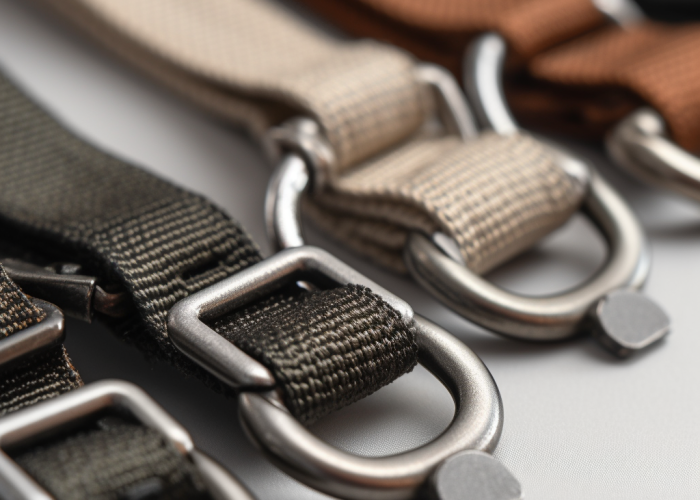

Webbing manufacturing expert with 15+ years of experience helping product developers build high-performance straps for industrial, medical, and outdoor use.
Webbing belt materials include nylon, polyester, polypropylene, elastic blends, and specialty fibers, each offering distinct performance characteristics. Nylon webbing delivers 7,000-9,000 lbs tensile strength per inch with 20-30% elasticity at breaking point. Polyester provides 6,500-8,000 lbs tensile strength with UV resistance and minimal stretch (2-3%). Polypropylene offers chemical resistance with 2,700-4,000 lbs strength, while specialty fibers can reach 15,000+ lbs tensile strength for extreme applications.
Nylon webbing dominates high-performance applications due to its exceptional molecular structure. Type 6 nylon offers 20-30% elasticity at breaking point, making it ideal for shock-absorbing applications like vehicle recovery straps. Type 6,6 nylon provides 15% greater tensile strength with reduced stretch (15-20%), making it superior for critical load-bearing industrial applications.
Nylon maintains 85% of its rated strength even after 5,000 cycles of repeated loading. Its hygroscopic properties increase stretch capacity by 8-10% in humid environments, requiring specific manufacturing considerations for applications in variable conditions.
Polyester webbing excels in applications requiring minimal stretch and environmental stability. High-tenacity polyester achieves 6,500-8,000 lbs tensile strength per inch while maintaining only 2-3% stretch at rated capacity. This material offers exceptional UV resistance, retaining 92% of its strength after 1,000 hours of accelerated UV exposure testing.
Polyester demonstrates minimal moisture absorption (0.4% vs. nylon’s 4.5%), ensuring consistent performance across varying humidity conditions. Manufacturing requires higher temperature settings (425-450°F) during heat-setting, creating more permanent crystalline structures that resist deformation.
Polypropylene webbing offers unique advantages for applications requiring chemical resistance and lightweight construction. With a specific gravity of 0.91, polypropylene creates webbing that’s 20% lighter while providing 2,700-4,000 lbs tensile strength per inch. Its molecular structure delivers exceptional resistance to acids, alkalis, and organic solvents.
Manufacturing considerations include lower melting points (320-330°F) requiring precise temperature control. Advanced stabilization must be incorporated during production to protect against UV degradation, as untreated polypropylene can lose significant strength after extended sunlight exposure.
Elastic webbing incorporates elastomeric fibers with carrier fibers to create materials with controlled stretch and recovery properties. Manufacturing techniques include core-spinning or weft-insertion methods to integrate elastic components.
Technical specifications typically include stretch capacity (80-200% depending on construction), cycle testing (maintaining 95% recovery after 10,000 stretch cycles), and modulus values. Applications requiring precise elastic performance demand rigorous quality control during manufacturing to ensure consistent stretch characteristics.
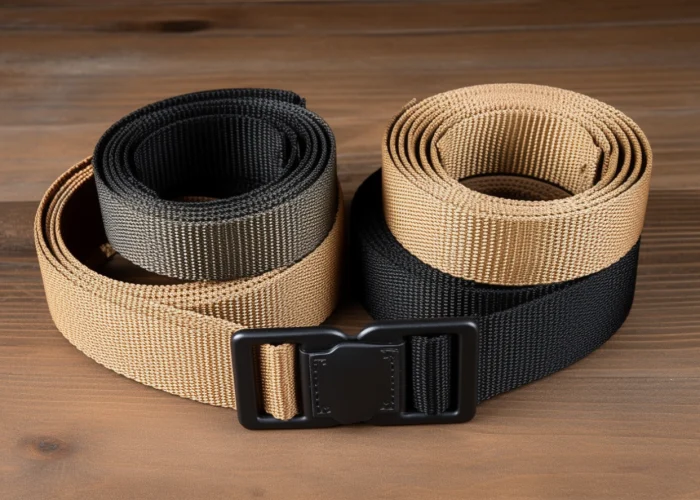
Standard webbing belt dimensions range from 1-inch to 4-inches in width and 1/16-inch to 2-inches in thickness, with specifications varying by application. Everyday casual belts typically measure 1-1.5 inches wide and 0.06-0.08 inches thick, while tactical belts require 1.75-2 inches width with 0.1-0.15 inches thickness. Industrial rigging webbing can reach 3-4 inches wide and up to 0.25 inches thick, providing tensile strength exceeding 12,000 pounds for critical load-bearing applications.
Width directly impacts load distribution and application suitability. Fashion webbing measures 1-1.25 inches, compatible with standard garment belt loops. Tactical and military applications require 1.75-2 inches width to support equipment without rolling. Heavy-duty industrial webbing spans 3-4 inches to distribute loads across broader areas, reducing pressure points.
Each 0.5-inch increase in width typically adds 25-30% to overall tensile strength when using identical materials and weave patterns. Narrow webbing (under 1.5 inches) is produced on needle looms at higher speeds, while wider webbing requires specialized equipment with precise tension control.
Thickness directly influences flexibility, load capacity, and durability. Light-duty webbing (0.04-0.06 inches) offers excellent flexibility for wearable applications. Medium-duty webbing (0.08-0.12 inches) balances flexibility with strength. Heavy-duty webbing (0.15-0.25 inches) prioritizes strength over flexibility for critical applications.
Manufacturing thickness maintains ±0.005 inch tolerance through controlled tension during weaving. Each 0.02-inch increase in thickness typically yields a 15-20% increase in breaking strength. Thicker webbing requires larger radius bends to prevent structural weakening at attachment points and connections.
Weight capacity increases with both width and thickness but follows non-linear relationships. A 2-inch webbing supports 2.2-2.5 times the load of 1-inch webbing due to improved load distribution. Doubling thickness increases load capacity by approximately 1.8-2.0 times due to material density factors.
Industry standards typically specify a 5:1 safety factor for critical applications. For lifting applications, manufacturers achieve this through dimensional increases rather than material changes, as dimensional modifications provide more predictable strength increases across environmental conditions.
The most universally compatible widths include 1-inch, 1.5-inch, and 2-inch specifications, aligning with standardized buckles and hardware. Custom dimensions require specialized tooling but enable optimized performance for specific applications.
Standard sizes offer 30-40% cost reduction through established tooling and streamlined production. Custom dimensions require dedicated loom setups and quality control protocols, extending production timelines by 40-50% compared to standard specifications.
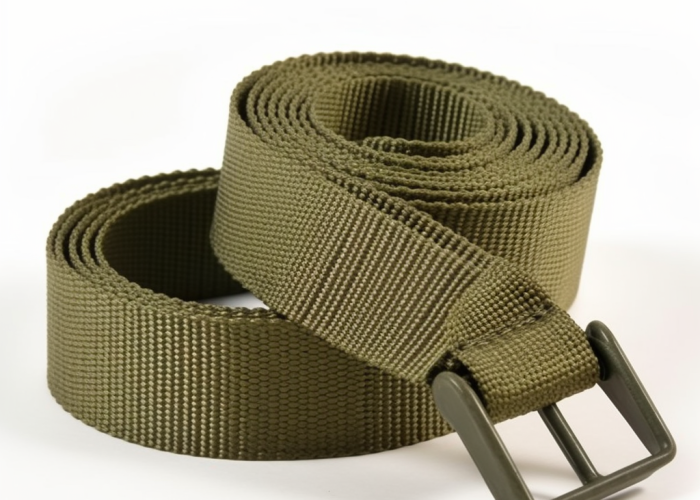
Custom webbing belts are manufactured through a multi-stage process including fiber preparation, weaving, heat-setting, finishing, and quality testing. The production begins with selecting appropriate synthetic yarns (typically nylon or polyester) that are then warped onto beams at precise tensions. These prepared fibers feed into specialized looms where the distinctive flat, tubular, or patterned webbing structure is created through controlled interlacing of warp and weft yarns.
We employ three primary weaving methods: shuttle looms for traditional patterns, needle looms for complex designs, and rapier looms for wider webbing. Flat-woven webbing uses a simple over-under pattern that maximizes production speed, while tubular-woven webbing creates a double-layer structure without edges for applications requiring uniform strength distribution.
Jacquard attachments enable intricate pattern creation directly in the weave structure, incorporating logos, text, or custom designs without sacrificing structural integrity. Pattern selection significantly impacts performance characteristics, with twill weaves offering 15-20% greater flexibility than plain weaves of identical materials.
After weaving, raw webbing undergoes heat-setting at precisely controlled temperatures (350-450°F depending on material) to stabilize dimensions and establish memory in the material structure. This critical step prevents subsequent shrinkage and ensures consistent performance under load.
Finishing treatments may include applying water-repellent coatings, flame-retardant chemicals, or UV inhibitors depending on application requirements. Edge treatments like ultrasonic sealing or hot-knife cutting prevent fraying while maintaining structural integrity at the webbing boundaries.
Every production batch undergoes standardized testing including tensile strength verification, elongation measurement, and abrasion resistance assessment. Continuous quality monitoring throughout production ensures dimensional stability with typical tolerances of ±0.5mm in width and ±0.1mm in thickness.
For custom webbing intended for safety-critical applications, additional testing includes cyclic loading, environmental exposure assessment, and accelerated aging protocols to verify performance throughout the expected service life.
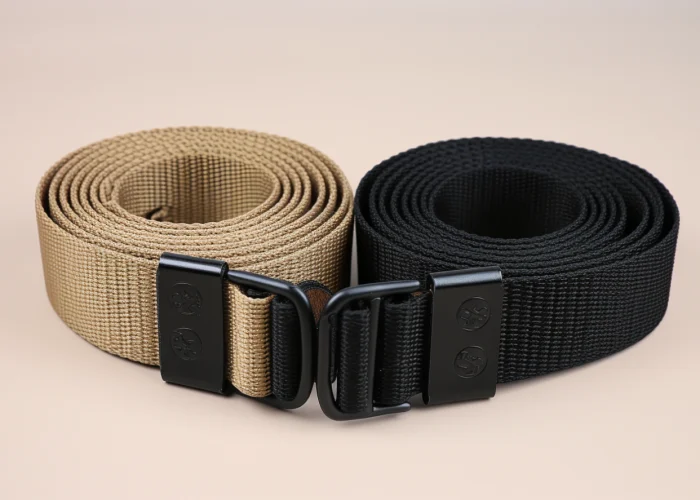
Buckle system compatibility with webbing depends on material properties, load requirements, and application environments. Military-style clamp buckles work optimally with nylon webbing due to their 3,000+ lb shear strength capacity, while slide mechanisms pair effectively with polyester webbing for applications requiring frequent adjustment. Quick-release systems integrate best with flexible webbing types featuring 10-15% elongation characteristics for secure engagement without material stress.
Webbing belts outperform traditional leather belts in technical applications by offering superior strength-to-weight ratio, environmental resistance, and customization possibilities. While leather belts provide 1,500-2,000 lbs tensile strength, synthetic webbing delivers 7,000-9,000 lbs per inch while weighing 40% less. Webbing maintains consistent performance in extreme temperatures (-40°F to 180°F) and resists moisture absorption, UV degradation, and chemical exposure that rapidly deteriorates leather.
Webbing offers 3-4× higher tensile strength than equivalent leather while maintaining consistent performance after thousands of load cycles. Unlike leather, webbing resists sudden failure and exhibits visible wear indicators before breaking. In wet conditions, webbing retains 85% of its strength compared to leather’s 50-60% retention, making it superior for marine and outdoor applications. Modern webbing also withstands exposure to fuels, oils, and chemicals that would quickly damage traditional leather.
Manufacturing webbing to precise dimensional tolerances (±0.5mm) enables consistent strength ratings with minimal batch variation. This precision allows product developer to accurately calculate load requirements and safety factors for critical applications. Webbing can also integrate specialized properties like reflective threads, RFID chips, or conductive elements directly into its structure without compromising strength—capabilities impossible with traditional leather construction.
In industrial safety applications, webbing’s higher breaking strength creates greater safety margins while consistent elongation characteristics enable precise load calculations. Military and tactical uses benefit from webbing’s faster drying time after submersion (1-2 hours vs. leather’s 24+ hours) and lower weight that reduces operator fatigue. For outdoor equipment, webbing’s superior resistance to environmental degradation significantly extends service life while offering greater configuration flexibility.
Webbing’s continuous manufacturing process offers reduced production variation through automated quality control compared to leather’s batch processing. This results in lower material waste (5-7% vs. leather’s 15-20%) and faster production throughput. While high-quality leather remains expensive with fluctuating prices, webbing provides consistent cost structure with higher strength-per-dollar value and extended service life in demanding environments.
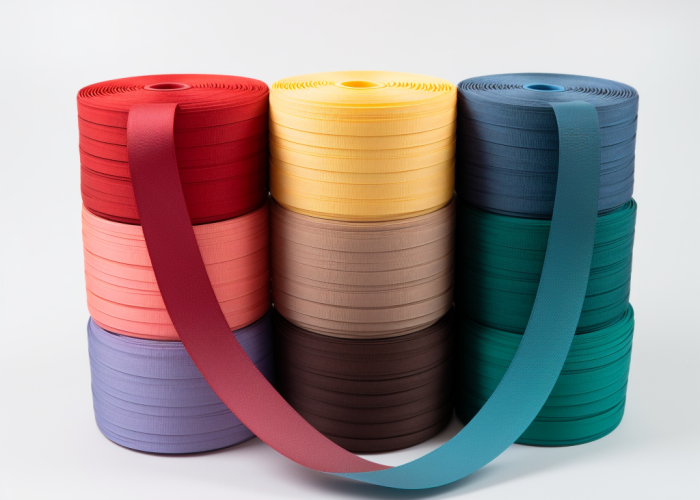
Webbing belts can be customized through material selection, dimensional specifications, specialized coatings, printing options, and hardware integration to meet precise application requirements. Manufacturers can alter weave patterns to modify flexibility (10-40% variation), adjust thickness to change load capacity (1,000-12,000 lbs), and incorporate special features like reflective threads, RFID tracking, or antimicrobial treatments for specialized environments.
Material blending creates webbing with hybrid properties tailored to specific applications. Combining nylon’s strength with polyester’s UV resistance produces webbing ideal for long-term outdoor exposure. Adding elastomeric components introduces controlled stretch (5-100%) while maintaining load capacity. Specialty fiber integration can deliver application-specific properties such as electrical conductivity, flame resistance (meeting NFPA 701 standards), or enhanced visibility through fluorescent or reflective elements.
Altering the fundamental weave structure significantly changes performance characteristics. Tubular construction eliminates edges for applications requiring uniform wear resistance. Ripstop patterns incorporate reinforcement threads at 3-6mm intervals, preventing tear propagation. Multi-layer constructions allow for differential properties on each side of the webbing, such as high-friction surfaces paired with low-abrasion backing. Custom edge treatments include ultrasonic sealing, hot cutting, or reinforced selvages for specific durability requirements.
Surface treatments modify performance without changing structural properties. Silicone impregnation increases water resistance while maintaining flexibility. Polyurethane coatings improve abrasion resistance by 60-80%. Anti-static treatments dissipate electrical charges in sensitive electronics handling. Direct dye sublimation or screen printing enables permanent branding, instruction markings, or measurement indicators accurate to ±1mm without compromising structural integrity, while jacquard weaving incorporates designs directly into the webbing structure.
Custom webbing regularly incorporates integrated hardware elements during manufacturing. Reinforced attachment points distribute stress across broader areas, increasing joint strength by 40-50%. Custom-positioned hardware mounting points eliminate field modifications. Specialized sleeves protect electronic components or temperature-sensitive elements. Designed break points can be engineered to fail at specific loads (±5% tolerance), protecting more expensive equipment or providing visual overload indicators for safety applications.
Webbing belts offer unmatched versatility through their customizable materials, dimensions, and integrated features. Whether you need specialized performance characteristics or application-specific modifications, custom webbing manufacturing provides engineers and product developers with precision-engineered solutions that outperform traditional alternatives in strength, durability, and adaptability for your exact requirements.
Minimum order quantities for custom webbing typically range from 500-1,000 meters for standard materials and 1,000-3,000 meters for specialized constructions. Lower quantities are available with higher per-unit pricing, while prototype development can be accommodated with surcharges for small-batch production runs.
Custom webbing production typically requires 15-20 business days for standard materials and 20-30 days for specialized constructions after design approval. Production timelines include material sourcing (3-5 days), loom setup (2-3 days), manufacturing (7-15 days), quality testing (2-3 days), and finishing processes (1-4 days).
Safety-critical webbing must meet industry-specific standards including ANSI Z359.1 for fall protection (15kN minimum strength), NFPA 1983 for rescue equipment (varying by class: light/medium/heavy duty), and ISO 9001/12402 for marine applications. Each standard requires documented testing for tensile strength, dynamic load response, and environmental resistance.
Yes, webbing can be manufactured to meet certifications including Berry Amendment compliance for military applications, OEKO-TEX Standard 100 for consumer safety, ISO 9001 for quality management systems, and REACH compliance for chemical safety. Certification requires extensive documentation and regular third-party verification testing.
Environmental exposure determines optimal material selection: high-UV environments require polyester or UV-stabilized nylon (92% strength retention after 1,000 hours exposure). Marine applications need salt-resistant treatments. Chemical exposure necessitates polypropylene or specialized coatings. Temperature extremes (-40°F to +180°F) demand appropriate material modification and stabilization.
Custom webbing lead times average 2-3 weeks for standard constructions and 3-4 weeks for specialized designs. Timeline factors include material availability (adding 1-2 weeks for exotic fibers), manufacturing queue (seasonally variable), testing requirements (adding 1 week for certified testing), and finishing processes. Rush production options typically available with 30-50% premium.
Toggle Content